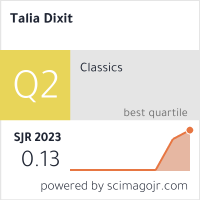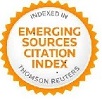La arenga de Tariq B. Ziyad: Un ejemplo de creación retórica en la historiografía árabe
DOI:
https://doi.org/10.17398/1886-9440.11.45Palabras clave:
Arenga, Islam, Tariq b. Ziyad, Historiografía, Retórica, TopoiResumen
Partiendo de la concepción de la historiografía como producto retórico, este artículo aborda el estudio de las arengas militares en contexto islámico como muestra de dicha actividad historiográfica. El caso de la arenga atribuida a Tariq b. Ziyad, conquistador musulmán de al-Andalus, servirá de ejemplo para ello. Su estudio textual y de contenido permitirá observar por un lado, la transmisión del texto a lo largo de los siglos en distintas versiones del mismo, y por otro, los topoi comunes a las arengas surgidas en otros contextos espaciotemporales y las peculiaridades del caso islámico.
Descargas
Referencias
Fuentes Primarias
FATH AL-ANDALUS (1994), Fath al-Andalus, ed. L. Molina, Madrid.
IBN AL-ATIR (1979), al-Kamil fi l-Ta’rij, ed. C. J. Tornberg, Beirut.
IBN AL-AZRAQ, Bada’i' al-silk fi taba’i' al-mulk [www.alwaraq.net]. IBN HABIB, Kitab al-Ta’rij [www.alwaraq.net].
IBN HUDAYL(1936), L’ornament des ames et la devise des habitans d’el Andalus, trad. L. Mercier, París.
IBN JALLIKAN, Wafayat al-a’yan wa-abna’ al-zaman [www.alwaraq.net].
IBN KATIR (2000), Tafsir al-Qur’an al-‘azim, ed. M. al-Sayyid Muhammad, M. al-Sayyid Rašad, M. Fadul al-Maŷmawi, ‘A. A. ‘Abd al-Baqi y H. ‘Abbas Qutb, El Cairo.
IBN AL-QUTIYYA (1926), Historia de la conquista de España de Abenalcotía el cordobés, ed. y trad. J. Ribera, Madrid.
IBN AL-ŠABBAT, Silat al-simt wa-simat al-mirt fi šarh simt al-hadi fi l-fajr al-Muhammadi[www.alwaraq.net]. Al-Imama wa l-siyasa [www.alwaraq.net].
AL-MAQQARI, Nafh al-Tib min gusn al-Andalus al-ratib [www.alwaraq.net].
AL-NUWAYRI (1917), Historia de los musulmanes de España y África por en-Nuguairí, ed. y trad. M. Gaspar Remiro, Granada.
AL-TURTUŠI, Siraŷ al-muluk [www.alwaraq.net]. AL-YAFI'I, Mir’at al-ŷinan wa-'ibrat al-yaqzan fi ma'rifat ma yu'tabar min hawadit al-zaman [www.alwaraq.net].
Bibliografía Secundaria
AA.VV. (EDS.) (1960-2009),Encyclopaedia of Islam (2ª Edición),Leiden: Brill // Edición electrónica (Brill-Online).
BACHRACH, B. S. (1985), “The practical use of Vegetius' De Re Militari during the Early Middle Ages”, Historian, 47: 2, 239-255.
BADAWI, E. M. y ‘ABD HALEM, M. (2008), Arabic-English Dictionary of Qur’anic Usage, Leiden-Boston.
BLIESE, J. R. E. (1989), “Rhetoric and morale: a study of battle orations from the central middle ages”, Journal of Medieval History, 15, 201-226.
____(1991a), “The courage of the Normans. A comparative study of battle rhetoric”, Nottingham Medieval Studies, 35, 1-26.
____(1991b), “When knightly courage may fail: battle orations in Medieval Europe”, Historian, 53: 3, 489-504.
BONNER, M.(2006), Jihad in Islamic history: doctrines and practice, Princeton.
CAMPBELL, B.(1987), “Teach yourself how to be a general”, The Journal of Roman Studies, 77, 13-29.
CARLÉ, Mª C.(1991),“Los miedos medievales (Castilla, siglo XV)”, Estudios de Historia de España, 4, 109-157.
CARMONA CENTENO,D. (2009), “Épica, historiografía y retórica: la epipólesis a diferentes naciones en la historiografía grecolatina”, Talia Dixit, 4, 1-28.
CATIGNANI, S.(2004), “Motivating Soldiers: The example of the Israeli Defence Forces”, Parameters, 34, 108-121.
CORTÉS, J. (Ed. y trad.) (1999), El Corán, Barcelona.
EHRHARDT, C. T. H. R. (1995),“Speeches before battle?”, Historia: Journal of Ancient History, 44: 1, pp. 120-121.
FIERRO, M. (2008), “Los pecados de los musulmanes: contrición, compasión y castigo”, en A. I. Carrasco Manchado y Mª P. Rábade Obradó (coords.), Pecar en la Edad Media, Madrid, pp. 327-357.
FIRESTONE,R. (1999), Jihad: the origin of holy war in Islam, New York.
FLEISCHMAN,S. (1983), “On the representation of History and Fiction in the middle ages”, History and Theory, 22: 3, 278-310.
FLORI, J. (2004), Guerra Santa, Yihad, Cruzada. Violencia y religión en el cristianismo y el Islam, trad. R. G. Peinado Santaella, Granada.
GARCÍA FITZ, F.(2003), La Edad Media. Guerra e ideología. Justificaciones religiosas y jurídicas, Madrid.
____(2008), “La arenga militar en la historiografía de las cruzadas: la ideología patente”, en J. C. Iglesias Zoido (Ed.), Retórica e Historiografía: el discurso militar en la historiografía desde la Antigüedad hasta el Renacimiento, Madrid, pp. 429-536.
GARCÍA SANJUÁN, A. (2008), “Formas de sumisión del territorio y tratamiento de los vencidos en el derecho islámico clásico”, en M. Fierro y F. García Fitz (Eds.), El cuerpo derrotado: cómo trataban musulmanes y cristianos a los enemigos vencidos (Península Ibérica, ss. VIII-XIII), Madrid,pp. 61-111.
HANNOUN, A. (2001),Colonial Histories, Post-Colonial Memories. The Legend of the Kahina, a North African heroine, Portsmouth.
HANSEN, M. H. (1993), “The Battle exhortation in Ancient historiography. Fact or fiction?”, Historia: Zeitschirift fûr Alte Geschichte, 42: 2, 161-180.
AL-HARRAS, 'A. S. (1968), “Jutbat Tariq ibn Ziyad min ŷadid”, Da'wat al-haqq, 5, 126-129.
IGLESIAS ZOIDO, J. C. (1996-2003), “La arenga militar en Jenofonte: a propósito de Ciropedia 3.3.48-55”, Norba. Revista de Historia 16, 157-166.
____ (2000), “¿Se pronunciaron realmente las arengas de Tucídides? El testimonio de Th. VII, 61-70”, Athenaeum (Pavia, Italy), 88: 2,515-528.
____ (2007), “Fantasmas del pasado frente a soldados del presente: retórica e historiografía en el nuevo enfoque cultural de la historia militar grecolatina”, Talia Dixit, 2, 221-233.
____(2008), “Retórica e Historiografía: la arenga militar”, en J. C. Iglesias Zoido (Ed.), Retórica e Historiografía. El discurso militar en la Historiografía desde la Antigüedad hasta el Renacimiento, Madrid, pp. 10-53.
JAFAŶI, M. 'A. M. (1962), Qissat al-adab fi l-Andalus, Beirut.
KARAPLI, K.(1993), “Speeches of Arab leaders to their warriors according to Byzantine texts”, Graeco-Arabica, 5, (Fourth international congress on Gareco-Oriental and Graeco-African studies), 233-242.
KEITEL, E.(1987), “Homeric antecedents to the cohortatio in the ancient historians”,Classical world, 80: 3, 153-172.
LANDAU-TASSERON, E. (2004), “On the reconstruction of lost sources”, Al-Qantara, 25: 1, 45-91.
LANE, E. W.(1863), Arabic-English Lexicon by Edward William Lane, London [Recurso online:http://www.tyndalearchive.com/TABS/Lane/].
MAKKI, M. (1957), “Egipto y los orígenes de la historiografía arábigo-española. Contribución al estudio de las primeras fuentes de historia hispanomusulmana”, Revista del Instituto de Estudios Islámicos en Madrid, 5, 157-248.
MILLER, R. F.(2008),In words and deeds. Battle Speeches in History, Nueva York.
MOLINA, L.(2006),“Técnicas de amplificatio en el Muqtabis de Ibn Hayyan”, Talia Dixit, 1, 55-79.
MORABIA, A. (1993), Le Gihad dans l’islam médiéval, París.
NOTH, A. (1989) en colaboración con L.I.CONRAD, The early Arabic historical tradition: a source-critical study, trad. M. Bonner, Nueva Jersey.
PANIAGUA AGUILAR, D. (2007), “La arenga militar desde la perspectiva de la tradición polemológica grecolatina”, Talia Dixit, 2, 1-25.
PRITCHETT, W. K. (1994),“The General’s Exhortations in Greek Warfare”, en Essays in Greek History, Amsterdam, pp. 27-109.
____ (2002),Ancient Greek Battle Speeches and a Palfrey, Amsterdam.
ROBERT, J. C. (2002), La doctrine du butin de guerre dans l’islam sunnite classique, Perpignan.
STORELLI, X. (2009), “Les harangues de la Bataille de l’Étendard”, Médievales, 57, 15-32.
TARHINI, F. (1990), Adab al-Jitaba fi sadr al-islam, Beirut.
VERBRUGGEN, J. F. (1977), The Art of Warfare in the Western Europe during the Middle Ages, Amsterdam, Nueva York y Oxford.
VERCELLIN, G. (2003), Instituciones del mundo musulmán, Barcelona.
VIGUERA, Mª. J. (coord.) (2000), Historia de España de Menéndez Pidal, vol. VIII: 3, Madrid.
AL-ŶANABI,H.Ŷ.(1984),Tanzimat al-ŷayš al-‘arabi al-islami fi l-‘asr al-umawi, Bagdad.












